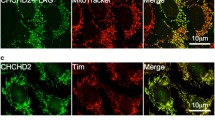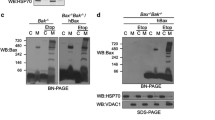Abstract
Bid is cleaved by caspase 8 during apoptosis and the truncated Bid (tBid) translocates to mitochondria by targeting cardiolipin. Amino acids 103–162 of Bid were reported as the cardiolipin-binding domain (CBD). The EGFP-CBD fusion protein targets to mitochondria and induces apoptosis. Using [3H]cardiolipin, we proved that recombinant CBD binds cardiolipin similar to tBid and tBid(G94E), a mutant with a defective BH3 domain. CBD could induce cytochrome c release from isolated mitochondria, but much less potent than tBid. Free cardiolipin inhibited the CBD-induced cytochrome c release, suggesting that it may be mediated by interfering with mitochondrial cardiolipin, especially with the interaction between cytochrome c and cardiolipin. This is consistent with the findings that CBD induced cytochrome c release in Bax-deficient cells, and that CBD suppressed mitochondrial respiration through directly interfering with cardiolipin, a critical lipid involved in oxidative phosphorylation. These results indicate the functional importance of CBD in tBid-induced apoptosis.
Similar content being viewed by others
References
Huang DC, Strasser A. BH3-Only proteins-essential initiators of apoptotic cell death. Cell 2000; 103: 839–842.
Gross A, McDonnell JM, Korsmeyer SJ. BCL-2 family members and the mitochondria in apoptosis. Genes Dev 1999; 13: 1899–1911.
Yin XM, Wang K, Gross A, et al.Bid-deficient mice are resistant to Fas-induced hepatocellular apoptosis. Nature 1999; 400: 886–891.
Li H, Zhu H, Xu CJ, Yuan J. Cleavage of BID by caspase 8 mediates the mitochondrial damage in the Fas pathway of apoptosis. Cell 1998; 94: 491–501.
Luo X, Budihardjo I, Zou H, Slaughter C, Wang X. Bid, a Bcl2 interacting protein, mediates cytochrome crelease from mitochondria in response to activation of cell surface death receptors. Cell 1998; 94: 481–490.
Wei MC, Lindsten T, Mootha VK, et al. tBID, a membranetargeted death ligand, oligomerizes BAK to release cytochrome c. Genes Dev 2000;14: 2060–2071.
Korsmeyer SJ, Wei MC, Saito M, Weiler S, Oh KJ, Schlesinger PH. Pro-apoptotic cascade activates BID, which oligomerizes BAK or BAX into pores that result in the release of cytochrome c. Cell Death Differ 2000; 7: 1166–1173.
Wei MC, Zong WX, Cheng EH, et al. Proapoptotic BAX and BAK: A requisite gateway to mitochondrial dysfunction and death. Science 2001; 292: 727–730.
Desagher S, Osen-Sand A, Montessuit S, et al. Phosphorylation of bid by casein kinases I and II regulates its cleavage by caspase n 8. Mol Cell 2001; 8: 601–611.
Letai A, Bassik MC, Walensky LD, Sorcinelli MD, Weiler S, Korsmeyer SJ. Distinct BH3 domains either sensitize or activate mitochondrial apoptosis, serving as prototype cancer therapeutics. Cancer Cell 2002; 2: 18–192.
Desagher S, Osen-Sand A, Nichols A, et al. Bid-induced conformational change of Bax is responsible for mitochondrial cytochrome crelease during apoptosis. J Cell Biol 1999; 144: 891–901.
Eskes R, Desagher S, Antonsson B, Martinou JC. Bid induces the oligomerization and insertion of Bax into the outer mitochondrial membrane. Mol Cell Biol 2000; 20: 929–935.
GrinbergM, Sarig R, ZaltsmanY, et al. tBID homooligomerizes in the mitochondrial membrane to induce apoptosis. J Biol Chem 2002; 277: 12237–12245.
Acehan D, Jiang X, Morgan DG, Heuser JE, Wang X, Akey CW. Three-dimensional structure of the apoptosome: Implications for assembly, procaspase-9 binding, and activation. Mol Cell 2002; 9: 423–432.
Zha J, Weiler S, Oh KJ, Wei MC, Korsmeyer SJ. Posttranslational N-myristoylation of BID as a molecular switch for targeting mitochondria and apoptosis. Science 2000; 290: 1761–1765.
Lutter M, Fang M, Luo X, Nishijima M, Xie X, Wang X. Cardiolipin provides specificity for targeting of tBid to mitochondria. Nat Cell Biol 2000; 2: 754–761.
Chou JJ, Li H, Salvesen GS, Yuan J, Wagner G. Solution structure of BID, an intracellular amplifier of apoptotic signaling.n Cell 1999; 96: 615–624.
McDonnell JM, Fushman D, Milliman CL, Korsmeyer SJ, Cowburn D. Solution structure of the proapoptotic molecule BID: A structural basis for apoptotic agonists and antagonists. Cell 1999; 96: 625–634.
Gottlieb E, Armour SM, Thompson CB. Mitochondrial respiratory control is lost during growth factor deprivation. Proc Natl Acad Sci USA 2002; 99: 12801–12806. 540 Apoptosis Vol 9 No 5 2004
Ghafourifar P, Klein SD, Schucht O, et al. Ceramide induces cytochrome c release from isolated mitochondria. Importance of mitochondrial redox state. J Biol Chem 1999; 274: 6080–6084.
Esposti MD, Erler JT, Hickman JA, Dive C. Bid. a widely expressed proapoptotic protein of the Bcl-2 family, displays lipid transfer activity. Mol Cell Biol 2001; 21: 7268–7276.
Basanez G, Sharpe JC, Galanis J, Brandt TB, Hardwick JM, Zimmerberg J. Bax-type apoptotic proteins porate pure lipid bilayers through a mechanism sensitive to intrinsic monolayer curvature. J Biol Chem 2002; 277: 49360–49365.
Epand RF, Martinou JC, Fornallaz-Mulhauser M, HughesDW, Epand RM. The apoptotic protein tBid promotes leakage by altering membrane curvature. J Biol Chem 2002; 277: 32632–32639.
Zhai D, Miao Q, Xin X, Yang F. Leakage and aggregation of phospholipid vesicles induced by the BH3-only Bcl-2 family member, BID. Eur J Biochem 2001; 268: 48–55.
Hu X, Han Z, Wyche JH, Hendrickson EA. Helix 6 of tBId is necessary but not sufficient for mitochondrial binding activity. Apoptosis 2003; 8: 277–289.
Esposti MD, Cristea IM, Gaskell SJ, NakaoY, Dive C. Proapoptotic Bid binds to monolysocardiolipin, a new molecular connection between mitochondrial membranes and cell death. Cell Death Differ 2003; 10: 1300–309.
Degli Esposti M. The mitochondrial battlefield and membrane lipids during cell death signalling. Ital J Biochem 2003; 52: 43–50.
Ott M, Robertson JD, Gogvadze V, Zhivotovsky B, Orrenius S. Cytochrome crelease from mitochondria proceeds by a twostep process. PNAS 2002; 99: 1259–1263.
Scorrano L, Ashiya M, Buttle K, et al. A distinct pathway remodels mitochondrial cristae and mobilizes cytochrome cduring apoptosis. Dev Cell 2002; 2: 55–67.
Shidoji Y, Hayashi K, Komura S, Ohishi N, Yagi K. Loss of molecular interaction between cytochrome cand cardiolipin due to lipid peroxidation. Biochem Biophys Res Commun 1999; 264: 343–347.
Kuwana T, Mackey MR, Perkins G, et al. Bid, bax, and lipids cooperate to form supramolecular openings in the outer mitochondrial membrane. Cell 2002; 111: 331–342.
Schlame M, Rua D, Greenberg ML. The biosynthesis and functional role of cardiolipin. Prog Lipid Res 2000; 39: 257–288.
Jiang F, Ryan MT, Schlame M, et al. Absence of cardiolipin in the crd1 null mutant results in decreased mitochondrial membrane potential and reduced mitochondrial function. J Biol Chem 2000; 275:22387–22394.
Koshkin V, Greenberg ML. Oxidative phosphorylation in cardiolipin-lacking yeast mitochondria. Biochem J 2000; 347Pt 3: 687–691.
Ostrander DB, Zhang M, Mileykovskaya E, Rho M, Dowhan W. Lack of mitochondrial anionic phospholipids causes an inhibition of translation of protein components of the electronm transport chain. A yeast genetic model system for the study of anionic phospholipid function in mitochondria. J Biol Chem 2001; 276: 25262–25272.
Author information
Authors and Affiliations
Corresponding author
Rights and permissions
About this article
Cite this article
Liu, J., Weiss, A., Durrant, D. et al. The cardiolipin-binding domain of Bid affects mitochondrial respiration and enhances cytochrome c release. Apoptosis 9, 533–541 (2004). https://doi.org/10.1023/B:APPT.0000038034.16230.ea
Issue Date:
DOI: https://doi.org/10.1023/B:APPT.0000038034.16230.ea




